BUSS701 Co-operative Education Portfolio 1: Expertise & Application
VerifiedAdded on 2023/06/14
|22
|7083
|408
Portfolio
AI Summary
This is a student's Portfolio 1 for BUSS701 Co-operative Education, focusing on developing expertise and applying knowledge in a business context. The portfolio reflects on feedback from a learning plan and demonstrates the application of management theories, such as Fayol's six functions of management and leadership theory, to the student's role as an office administrator. It evaluates the student's performance, highlighting strengths and areas for development, including improving cross-cultural communication skills. The document also includes sections on professional skills, goal setting, and working effectively with others, as well as a media log and evidence of the workspace. Desklib is a platform where students can find similar solved assignments and past papers.
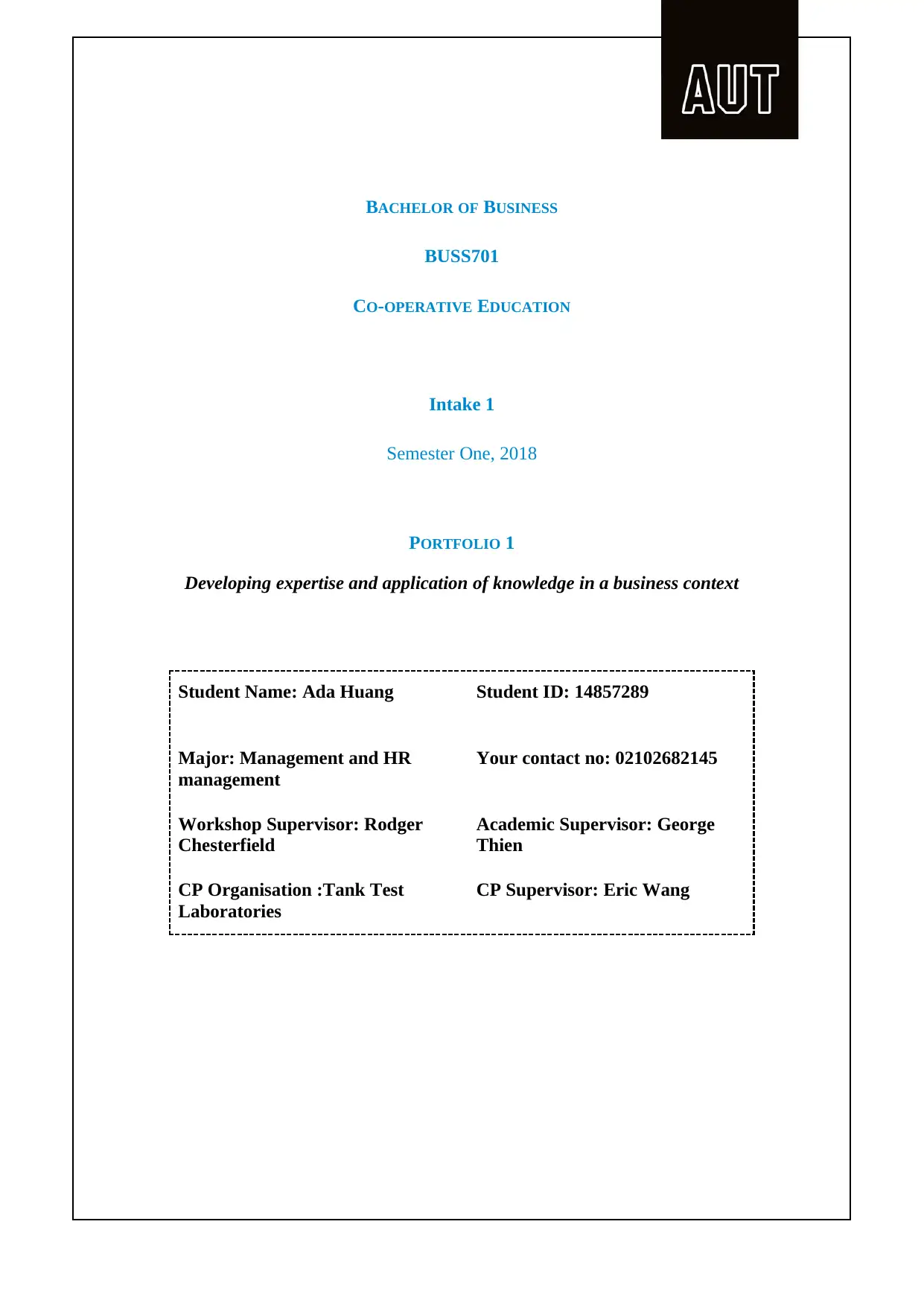
BACHELOR OF BUSINESS
BUSS701
CO-OPERATIVE EDUCATION
Intake 1
Semester One, 2018
PORTFOLIO 1
Developing expertise and application of knowledge in a business context
Student Name: Ada Huang Student ID: 14857289
Major: Management and HR
management
Your contact no: 02102682145
Workshop Supervisor: Rodger
Chesterfield
Academic Supervisor: George
Thien
CP Organisation :Tank Test
Laboratories
CP Supervisor: Eric Wang
BUSS701
CO-OPERATIVE EDUCATION
Intake 1
Semester One, 2018
PORTFOLIO 1
Developing expertise and application of knowledge in a business context
Student Name: Ada Huang Student ID: 14857289
Major: Management and HR
management
Your contact no: 02102682145
Workshop Supervisor: Rodger
Chesterfield
Academic Supervisor: George
Thien
CP Organisation :Tank Test
Laboratories
CP Supervisor: Eric Wang
Paraphrase This Document
Need a fresh take? Get an instant paraphrase of this document with our AI Paraphraser
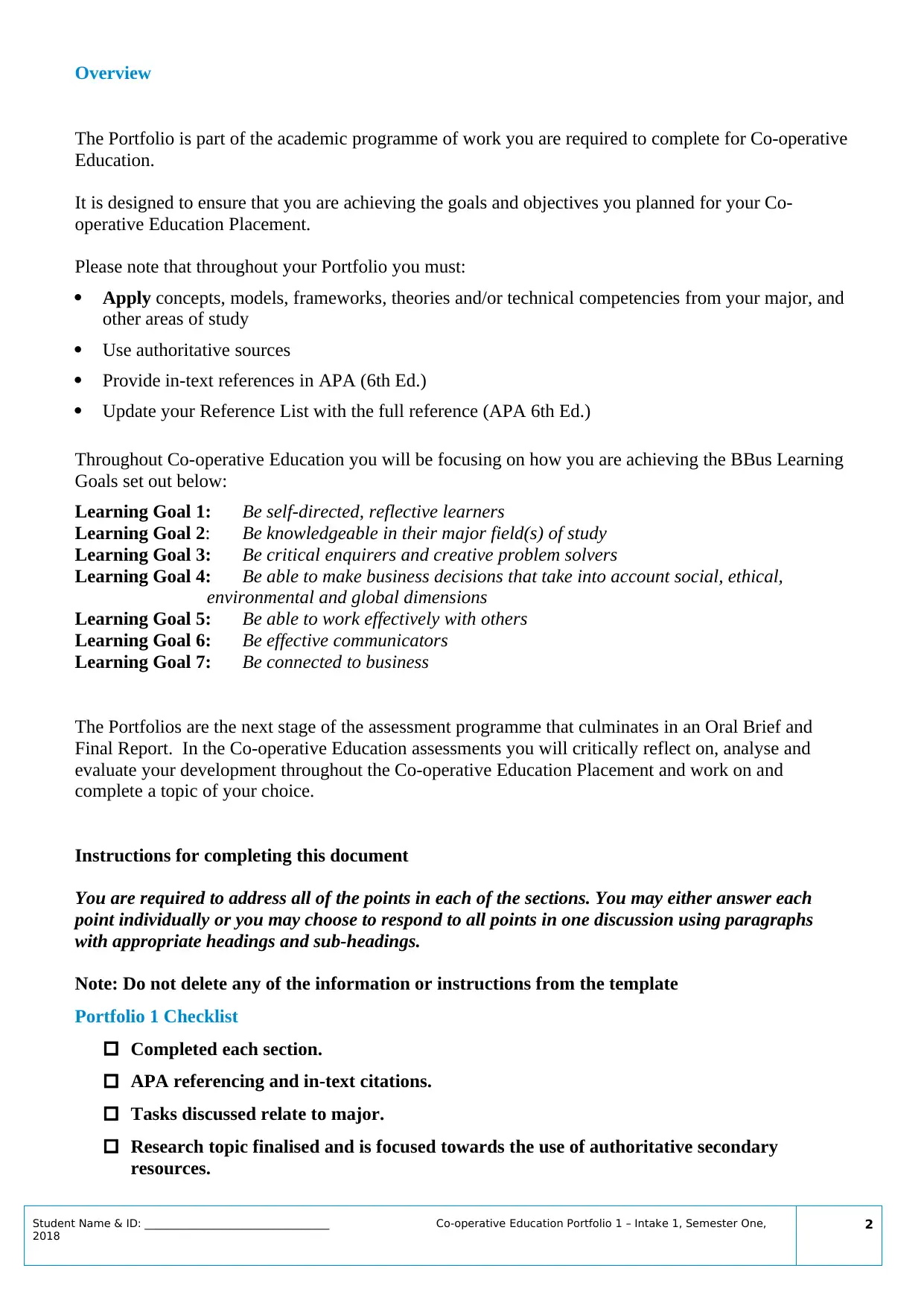
Overview
The Portfolio is part of the academic programme of work you are required to complete for Co-operative
Education.
It is designed to ensure that you are achieving the goals and objectives you planned for your Co-
operative Education Placement.
Please note that throughout your Portfolio you must:
Apply concepts, models, frameworks, theories and/or technical competencies from your major, and
other areas of study
Use authoritative sources
Provide in-text references in APA (6th Ed.)
Update your Reference List with the full reference (APA 6th Ed.)
Throughout Co-operative Education you will be focusing on how you are achieving the BBus Learning
Goals set out below:
Learning Goal 1: Be self-directed, reflective learners
Learning Goal 2: Be knowledgeable in their major field(s) of study
Learning Goal 3: Be critical enquirers and creative problem solvers
Learning Goal 4: Be able to make business decisions that take into account social, ethical,
environmental and global dimensions
Learning Goal 5: Be able to work effectively with others
Learning Goal 6: Be effective communicators
Learning Goal 7: Be connected to business
The Portfolios are the next stage of the assessment programme that culminates in an Oral Brief and
Final Report. In the Co-operative Education assessments you will critically reflect on, analyse and
evaluate your development throughout the Co-operative Education Placement and work on and
complete a topic of your choice.
Instructions for completing this document
You are required to address all of the points in each of the sections. You may either answer each
point individually or you may choose to respond to all points in one discussion using paragraphs
with appropriate headings and sub-headings.
Note: Do not delete any of the information or instructions from the template
Portfolio 1 Checklist
Completed each section.
APA referencing and in-text citations.
Tasks discussed relate to major.
Research topic finalised and is focused towards the use of authoritative secondary
resources.
Student Name & ID: __________________________________ Co-operative Education Portfolio 1 – Intake 1, Semester One,
2018
2
The Portfolio is part of the academic programme of work you are required to complete for Co-operative
Education.
It is designed to ensure that you are achieving the goals and objectives you planned for your Co-
operative Education Placement.
Please note that throughout your Portfolio you must:
Apply concepts, models, frameworks, theories and/or technical competencies from your major, and
other areas of study
Use authoritative sources
Provide in-text references in APA (6th Ed.)
Update your Reference List with the full reference (APA 6th Ed.)
Throughout Co-operative Education you will be focusing on how you are achieving the BBus Learning
Goals set out below:
Learning Goal 1: Be self-directed, reflective learners
Learning Goal 2: Be knowledgeable in their major field(s) of study
Learning Goal 3: Be critical enquirers and creative problem solvers
Learning Goal 4: Be able to make business decisions that take into account social, ethical,
environmental and global dimensions
Learning Goal 5: Be able to work effectively with others
Learning Goal 6: Be effective communicators
Learning Goal 7: Be connected to business
The Portfolios are the next stage of the assessment programme that culminates in an Oral Brief and
Final Report. In the Co-operative Education assessments you will critically reflect on, analyse and
evaluate your development throughout the Co-operative Education Placement and work on and
complete a topic of your choice.
Instructions for completing this document
You are required to address all of the points in each of the sections. You may either answer each
point individually or you may choose to respond to all points in one discussion using paragraphs
with appropriate headings and sub-headings.
Note: Do not delete any of the information or instructions from the template
Portfolio 1 Checklist
Completed each section.
APA referencing and in-text citations.
Tasks discussed relate to major.
Research topic finalised and is focused towards the use of authoritative secondary
resources.
Student Name & ID: __________________________________ Co-operative Education Portfolio 1 – Intake 1, Semester One,
2018
2
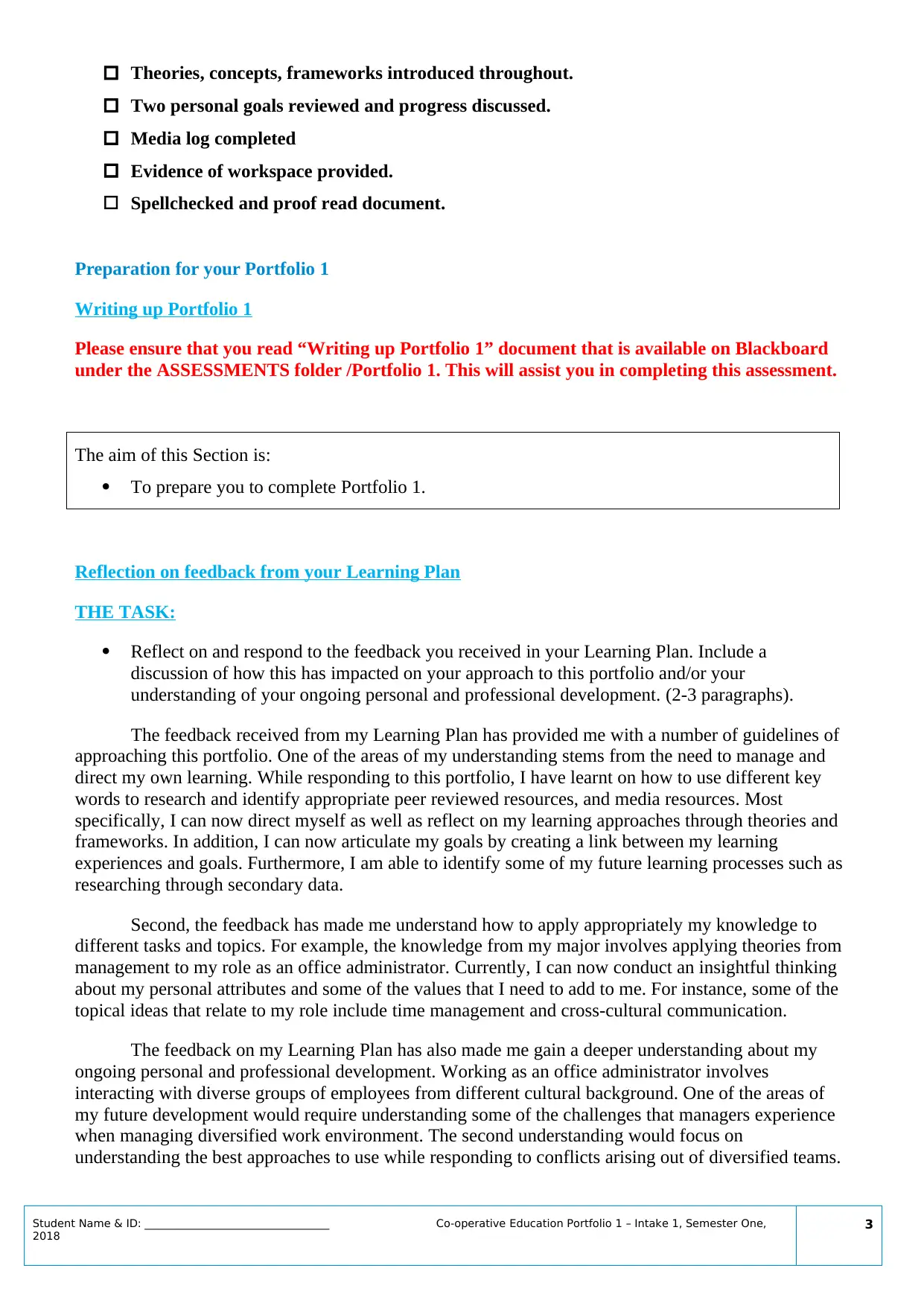
Theories, concepts, frameworks introduced throughout.
Two personal goals reviewed and progress discussed.
Media log completed
Evidence of workspace provided.
Spellchecked and proof read document.
Preparation for your Portfolio 1
Writing up Portfolio 1
Please ensure that you read “Writing up Portfolio 1” document that is available on Blackboard
under the ASSESSMENTS folder /Portfolio 1. This will assist you in completing this assessment.
The aim of this Section is:
To prepare you to complete Portfolio 1.
Reflection on feedback from your Learning Plan
THE TASK:
Reflect on and respond to the feedback you received in your Learning Plan. Include a
discussion of how this has impacted on your approach to this portfolio and/or your
understanding of your ongoing personal and professional development. (2-3 paragraphs).
The feedback received from my Learning Plan has provided me with a number of guidelines of
approaching this portfolio. One of the areas of my understanding stems from the need to manage and
direct my own learning. While responding to this portfolio, I have learnt on how to use different key
words to research and identify appropriate peer reviewed resources, and media resources. Most
specifically, I can now direct myself as well as reflect on my learning approaches through theories and
frameworks. In addition, I can now articulate my goals by creating a link between my learning
experiences and goals. Furthermore, I am able to identify some of my future learning processes such as
researching through secondary data.
Second, the feedback has made me understand how to apply appropriately my knowledge to
different tasks and topics. For example, the knowledge from my major involves applying theories from
management to my role as an office administrator. Currently, I can now conduct an insightful thinking
about my personal attributes and some of the values that I need to add to me. For instance, some of the
topical ideas that relate to my role include time management and cross-cultural communication.
The feedback on my Learning Plan has also made me gain a deeper understanding about my
ongoing personal and professional development. Working as an office administrator involves
interacting with diverse groups of employees from different cultural background. One of the areas of
my future development would require understanding some of the challenges that managers experience
when managing diversified work environment. The second understanding would focus on
understanding the best approaches to use while responding to conflicts arising out of diversified teams.
Student Name & ID: __________________________________ Co-operative Education Portfolio 1 – Intake 1, Semester One,
2018
3
Two personal goals reviewed and progress discussed.
Media log completed
Evidence of workspace provided.
Spellchecked and proof read document.
Preparation for your Portfolio 1
Writing up Portfolio 1
Please ensure that you read “Writing up Portfolio 1” document that is available on Blackboard
under the ASSESSMENTS folder /Portfolio 1. This will assist you in completing this assessment.
The aim of this Section is:
To prepare you to complete Portfolio 1.
Reflection on feedback from your Learning Plan
THE TASK:
Reflect on and respond to the feedback you received in your Learning Plan. Include a
discussion of how this has impacted on your approach to this portfolio and/or your
understanding of your ongoing personal and professional development. (2-3 paragraphs).
The feedback received from my Learning Plan has provided me with a number of guidelines of
approaching this portfolio. One of the areas of my understanding stems from the need to manage and
direct my own learning. While responding to this portfolio, I have learnt on how to use different key
words to research and identify appropriate peer reviewed resources, and media resources. Most
specifically, I can now direct myself as well as reflect on my learning approaches through theories and
frameworks. In addition, I can now articulate my goals by creating a link between my learning
experiences and goals. Furthermore, I am able to identify some of my future learning processes such as
researching through secondary data.
Second, the feedback has made me understand how to apply appropriately my knowledge to
different tasks and topics. For example, the knowledge from my major involves applying theories from
management to my role as an office administrator. Currently, I can now conduct an insightful thinking
about my personal attributes and some of the values that I need to add to me. For instance, some of the
topical ideas that relate to my role include time management and cross-cultural communication.
The feedback on my Learning Plan has also made me gain a deeper understanding about my
ongoing personal and professional development. Working as an office administrator involves
interacting with diverse groups of employees from different cultural background. One of the areas of
my future development would require understanding some of the challenges that managers experience
when managing diversified work environment. The second understanding would focus on
understanding the best approaches to use while responding to conflicts arising out of diversified teams.
Student Name & ID: __________________________________ Co-operative Education Portfolio 1 – Intake 1, Semester One,
2018
3
⊘ This is a preview!⊘
Do you want full access?
Subscribe today to unlock all pages.

Trusted by 1+ million students worldwide
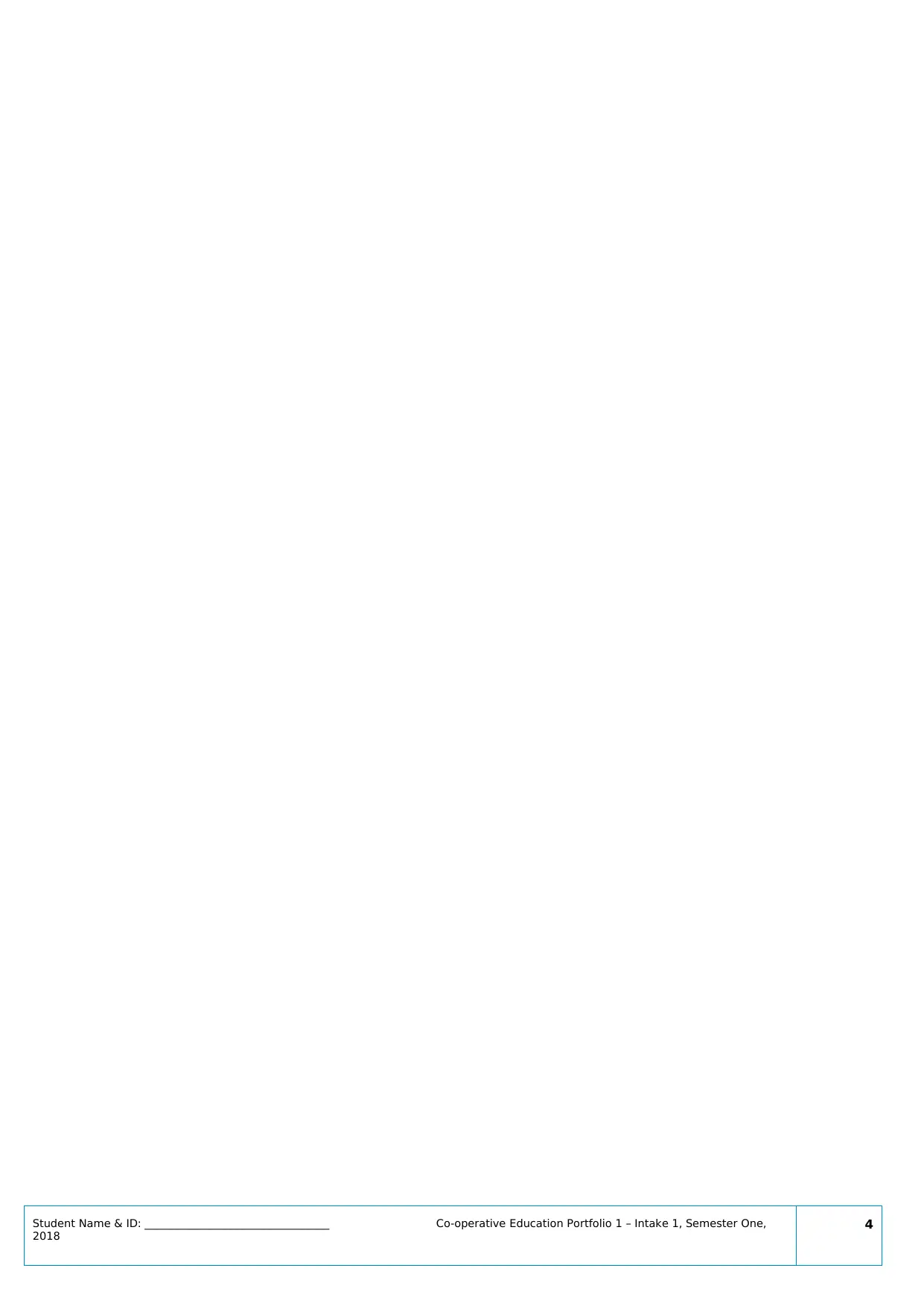
Student Name & ID: __________________________________ Co-operative Education Portfolio 1 – Intake 1, Semester One,
2018
4
2018
4
Paraphrase This Document
Need a fresh take? Get an instant paraphrase of this document with our AI Paraphraser
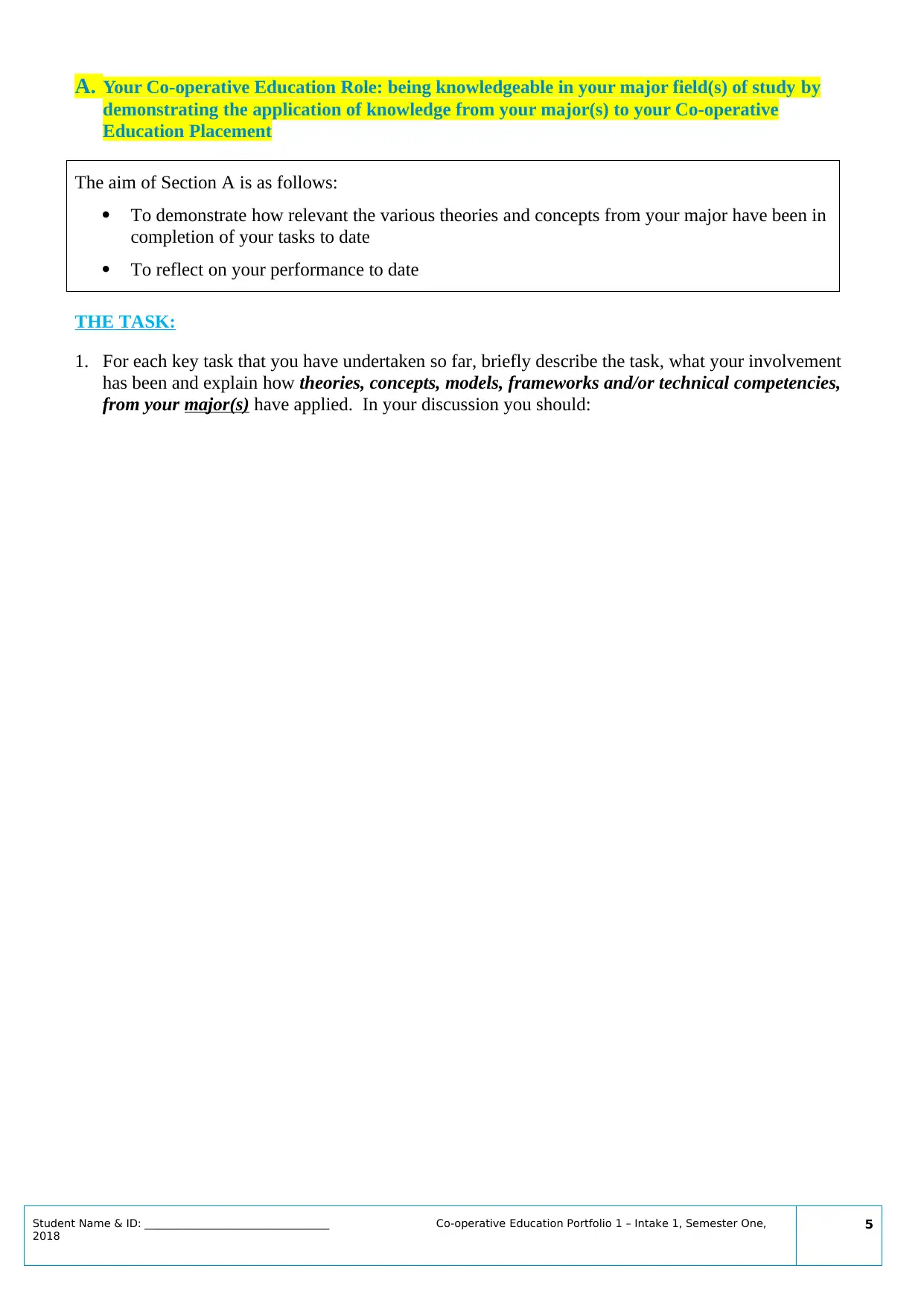
A. Your Co-operative Education Role: being knowledgeable in your major field(s) of study by
demonstrating the application of knowledge from your major(s) to your Co-operative
Education Placement
The aim of Section A is as follows:
To demonstrate how relevant the various theories and concepts from your major have been in
completion of your tasks to date
To reflect on your performance to date
THE TASK:
1. For each key task that you have undertaken so far, briefly describe the task, what your involvement
has been and explain how theories, concepts, models, frameworks and/or technical competencies,
from your major(s) have applied. In your discussion you should:
Student Name & ID: __________________________________ Co-operative Education Portfolio 1 – Intake 1, Semester One,
2018
5
demonstrating the application of knowledge from your major(s) to your Co-operative
Education Placement
The aim of Section A is as follows:
To demonstrate how relevant the various theories and concepts from your major have been in
completion of your tasks to date
To reflect on your performance to date
THE TASK:
1. For each key task that you have undertaken so far, briefly describe the task, what your involvement
has been and explain how theories, concepts, models, frameworks and/or technical competencies,
from your major(s) have applied. In your discussion you should:
Student Name & ID: __________________________________ Co-operative Education Portfolio 1 – Intake 1, Semester One,
2018
5
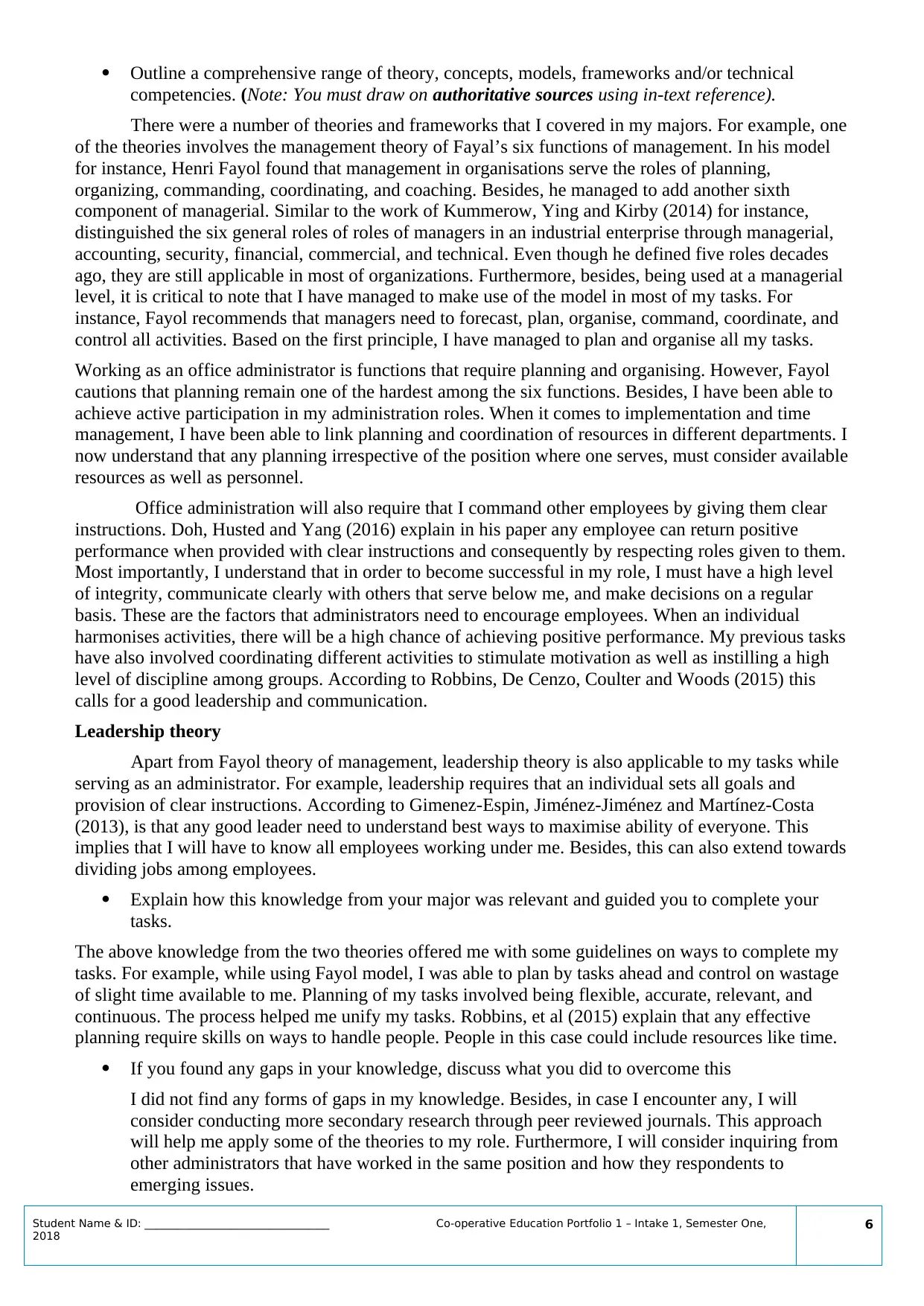
Outline a comprehensive range of theory, concepts, models, frameworks and/or technical
competencies. (Note: You must draw on authoritative sources using in-text reference).
There were a number of theories and frameworks that I covered in my majors. For example, one
of the theories involves the management theory of Fayal’s six functions of management. In his model
for instance, Henri Fayol found that management in organisations serve the roles of planning,
organizing, commanding, coordinating, and coaching. Besides, he managed to add another sixth
component of managerial. Similar to the work of Kummerow, Ying and Kirby (2014) for instance,
distinguished the six general roles of roles of managers in an industrial enterprise through managerial,
accounting, security, financial, commercial, and technical. Even though he defined five roles decades
ago, they are still applicable in most of organizations. Furthermore, besides, being used at a managerial
level, it is critical to note that I have managed to make use of the model in most of my tasks. For
instance, Fayol recommends that managers need to forecast, plan, organise, command, coordinate, and
control all activities. Based on the first principle, I have managed to plan and organise all my tasks.
Working as an office administrator is functions that require planning and organising. However, Fayol
cautions that planning remain one of the hardest among the six functions. Besides, I have been able to
achieve active participation in my administration roles. When it comes to implementation and time
management, I have been able to link planning and coordination of resources in different departments. I
now understand that any planning irrespective of the position where one serves, must consider available
resources as well as personnel.
Office administration will also require that I command other employees by giving them clear
instructions. Doh, Husted and Yang (2016) explain in his paper any employee can return positive
performance when provided with clear instructions and consequently by respecting roles given to them.
Most importantly, I understand that in order to become successful in my role, I must have a high level
of integrity, communicate clearly with others that serve below me, and make decisions on a regular
basis. These are the factors that administrators need to encourage employees. When an individual
harmonises activities, there will be a high chance of achieving positive performance. My previous tasks
have also involved coordinating different activities to stimulate motivation as well as instilling a high
level of discipline among groups. According to Robbins, De Cenzo, Coulter and Woods (2015) this
calls for a good leadership and communication.
Leadership theory
Apart from Fayol theory of management, leadership theory is also applicable to my tasks while
serving as an administrator. For example, leadership requires that an individual sets all goals and
provision of clear instructions. According to Gimenez-Espin, Jiménez-Jiménez and Martínez-Costa
(2013), is that any good leader need to understand best ways to maximise ability of everyone. This
implies that I will have to know all employees working under me. Besides, this can also extend towards
dividing jobs among employees.
Explain how this knowledge from your major was relevant and guided you to complete your
tasks.
The above knowledge from the two theories offered me with some guidelines on ways to complete my
tasks. For example, while using Fayol model, I was able to plan by tasks ahead and control on wastage
of slight time available to me. Planning of my tasks involved being flexible, accurate, relevant, and
continuous. The process helped me unify my tasks. Robbins, et al (2015) explain that any effective
planning require skills on ways to handle people. People in this case could include resources like time.
If you found any gaps in your knowledge, discuss what you did to overcome this
I did not find any forms of gaps in my knowledge. Besides, in case I encounter any, I will
consider conducting more secondary research through peer reviewed journals. This approach
will help me apply some of the theories to my role. Furthermore, I will consider inquiring from
other administrators that have worked in the same position and how they respondents to
emerging issues.
Student Name & ID: __________________________________ Co-operative Education Portfolio 1 – Intake 1, Semester One,
2018
6
competencies. (Note: You must draw on authoritative sources using in-text reference).
There were a number of theories and frameworks that I covered in my majors. For example, one
of the theories involves the management theory of Fayal’s six functions of management. In his model
for instance, Henri Fayol found that management in organisations serve the roles of planning,
organizing, commanding, coordinating, and coaching. Besides, he managed to add another sixth
component of managerial. Similar to the work of Kummerow, Ying and Kirby (2014) for instance,
distinguished the six general roles of roles of managers in an industrial enterprise through managerial,
accounting, security, financial, commercial, and technical. Even though he defined five roles decades
ago, they are still applicable in most of organizations. Furthermore, besides, being used at a managerial
level, it is critical to note that I have managed to make use of the model in most of my tasks. For
instance, Fayol recommends that managers need to forecast, plan, organise, command, coordinate, and
control all activities. Based on the first principle, I have managed to plan and organise all my tasks.
Working as an office administrator is functions that require planning and organising. However, Fayol
cautions that planning remain one of the hardest among the six functions. Besides, I have been able to
achieve active participation in my administration roles. When it comes to implementation and time
management, I have been able to link planning and coordination of resources in different departments. I
now understand that any planning irrespective of the position where one serves, must consider available
resources as well as personnel.
Office administration will also require that I command other employees by giving them clear
instructions. Doh, Husted and Yang (2016) explain in his paper any employee can return positive
performance when provided with clear instructions and consequently by respecting roles given to them.
Most importantly, I understand that in order to become successful in my role, I must have a high level
of integrity, communicate clearly with others that serve below me, and make decisions on a regular
basis. These are the factors that administrators need to encourage employees. When an individual
harmonises activities, there will be a high chance of achieving positive performance. My previous tasks
have also involved coordinating different activities to stimulate motivation as well as instilling a high
level of discipline among groups. According to Robbins, De Cenzo, Coulter and Woods (2015) this
calls for a good leadership and communication.
Leadership theory
Apart from Fayol theory of management, leadership theory is also applicable to my tasks while
serving as an administrator. For example, leadership requires that an individual sets all goals and
provision of clear instructions. According to Gimenez-Espin, Jiménez-Jiménez and Martínez-Costa
(2013), is that any good leader need to understand best ways to maximise ability of everyone. This
implies that I will have to know all employees working under me. Besides, this can also extend towards
dividing jobs among employees.
Explain how this knowledge from your major was relevant and guided you to complete your
tasks.
The above knowledge from the two theories offered me with some guidelines on ways to complete my
tasks. For example, while using Fayol model, I was able to plan by tasks ahead and control on wastage
of slight time available to me. Planning of my tasks involved being flexible, accurate, relevant, and
continuous. The process helped me unify my tasks. Robbins, et al (2015) explain that any effective
planning require skills on ways to handle people. People in this case could include resources like time.
If you found any gaps in your knowledge, discuss what you did to overcome this
I did not find any forms of gaps in my knowledge. Besides, in case I encounter any, I will
consider conducting more secondary research through peer reviewed journals. This approach
will help me apply some of the theories to my role. Furthermore, I will consider inquiring from
other administrators that have worked in the same position and how they respondents to
emerging issues.
Student Name & ID: __________________________________ Co-operative Education Portfolio 1 – Intake 1, Semester One,
2018
6
⊘ This is a preview!⊘
Do you want full access?
Subscribe today to unlock all pages.

Trusted by 1+ million students worldwide
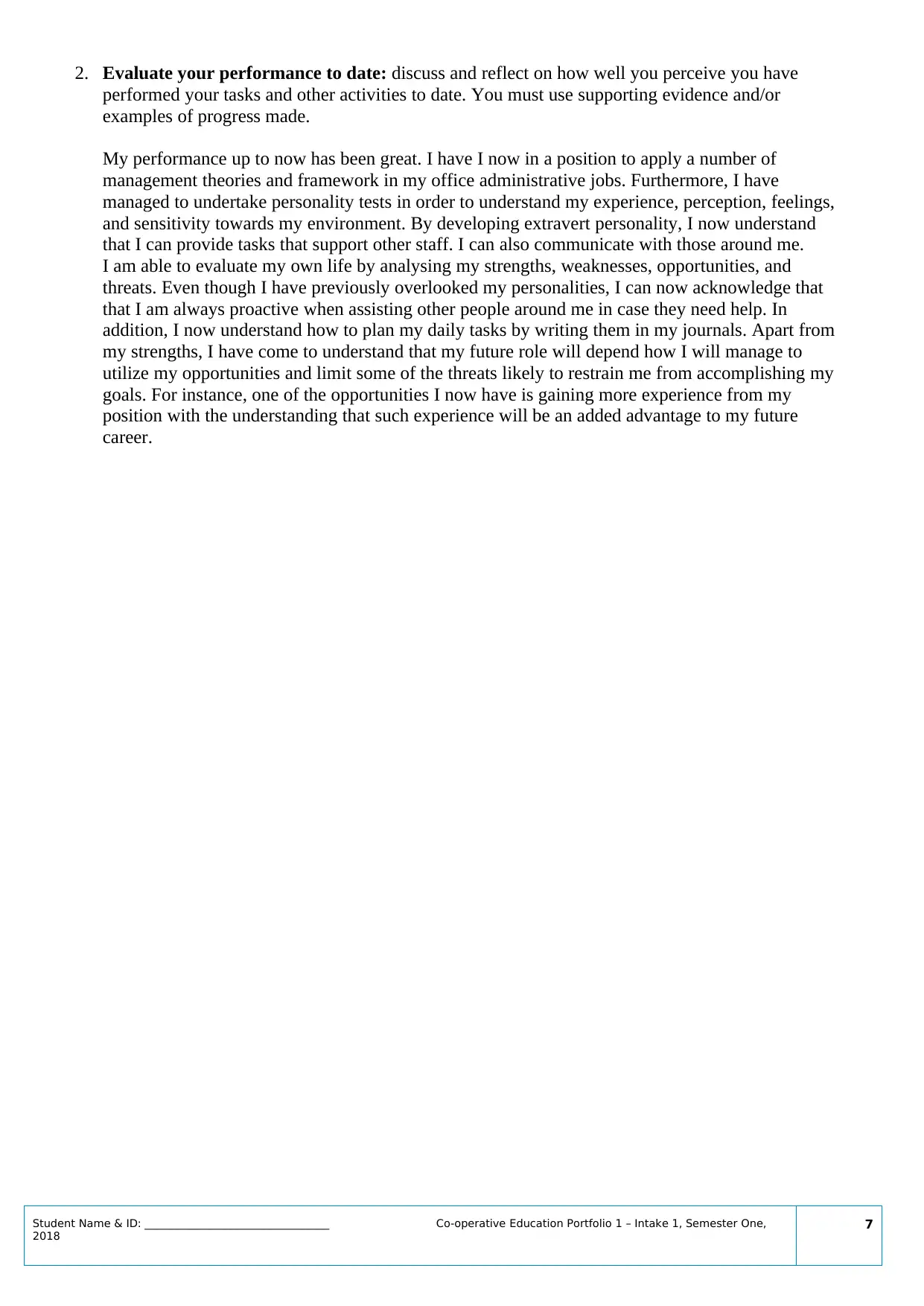
2. Evaluate your performance to date: discuss and reflect on how well you perceive you have
performed your tasks and other activities to date. You must use supporting evidence and/or
examples of progress made.
My performance up to now has been great. I have I now in a position to apply a number of
management theories and framework in my office administrative jobs. Furthermore, I have
managed to undertake personality tests in order to understand my experience, perception, feelings,
and sensitivity towards my environment. By developing extravert personality, I now understand
that I can provide tasks that support other staff. I can also communicate with those around me.
I am able to evaluate my own life by analysing my strengths, weaknesses, opportunities, and
threats. Even though I have previously overlooked my personalities, I can now acknowledge that
that I am always proactive when assisting other people around me in case they need help. In
addition, I now understand how to plan my daily tasks by writing them in my journals. Apart from
my strengths, I have come to understand that my future role will depend how I will manage to
utilize my opportunities and limit some of the threats likely to restrain me from accomplishing my
goals. For instance, one of the opportunities I now have is gaining more experience from my
position with the understanding that such experience will be an added advantage to my future
career.
Student Name & ID: __________________________________ Co-operative Education Portfolio 1 – Intake 1, Semester One,
2018
7
performed your tasks and other activities to date. You must use supporting evidence and/or
examples of progress made.
My performance up to now has been great. I have I now in a position to apply a number of
management theories and framework in my office administrative jobs. Furthermore, I have
managed to undertake personality tests in order to understand my experience, perception, feelings,
and sensitivity towards my environment. By developing extravert personality, I now understand
that I can provide tasks that support other staff. I can also communicate with those around me.
I am able to evaluate my own life by analysing my strengths, weaknesses, opportunities, and
threats. Even though I have previously overlooked my personalities, I can now acknowledge that
that I am always proactive when assisting other people around me in case they need help. In
addition, I now understand how to plan my daily tasks by writing them in my journals. Apart from
my strengths, I have come to understand that my future role will depend how I will manage to
utilize my opportunities and limit some of the threats likely to restrain me from accomplishing my
goals. For instance, one of the opportunities I now have is gaining more experience from my
position with the understanding that such experience will be an added advantage to my future
career.
Student Name & ID: __________________________________ Co-operative Education Portfolio 1 – Intake 1, Semester One,
2018
7
Paraphrase This Document
Need a fresh take? Get an instant paraphrase of this document with our AI Paraphraser
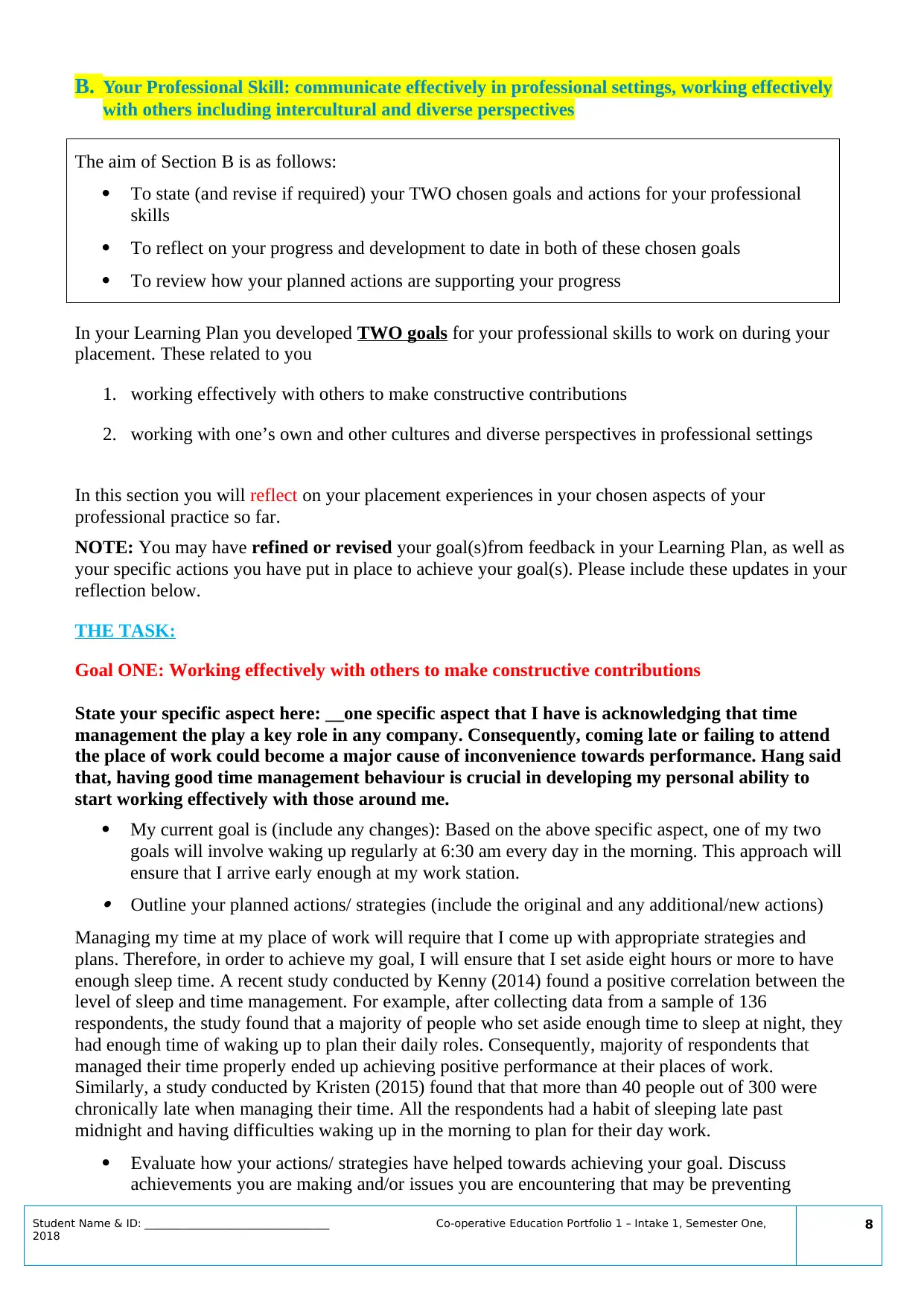
B. Your Professional Skill: communicate effectively in professional settings, working effectively
with others including intercultural and diverse perspectives
The aim of Section B is as follows:
To state (and revise if required) your TWO chosen goals and actions for your professional
skills
To reflect on your progress and development to date in both of these chosen goals
To review how your planned actions are supporting your progress
In your Learning Plan you developed TWO goals for your professional skills to work on during your
placement. These related to you
1. working effectively with others to make constructive contributions
2. working with one’s own and other cultures and diverse perspectives in professional settings
In this section you will reflect on your placement experiences in your chosen aspects of your
professional practice so far.
NOTE: You may have refined or revised your goal(s)from feedback in your Learning Plan, as well as
your specific actions you have put in place to achieve your goal(s). Please include these updates in your
reflection below.
THE TASK:
Goal ONE: Working effectively with others to make constructive contributions
State your specific aspect here: __one specific aspect that I have is acknowledging that time
management the play a key role in any company. Consequently, coming late or failing to attend
the place of work could become a major cause of inconvenience towards performance. Hang said
that, having good time management behaviour is crucial in developing my personal ability to
start working effectively with those around me.
My current goal is (include any changes): Based on the above specific aspect, one of my two
goals will involve waking up regularly at 6:30 am every day in the morning. This approach will
ensure that I arrive early enough at my work station. Outline your planned actions/ strategies (include the original and any additional/new actions)
Managing my time at my place of work will require that I come up with appropriate strategies and
plans. Therefore, in order to achieve my goal, I will ensure that I set aside eight hours or more to have
enough sleep time. A recent study conducted by Kenny (2014) found a positive correlation between the
level of sleep and time management. For example, after collecting data from a sample of 136
respondents, the study found that a majority of people who set aside enough time to sleep at night, they
had enough time of waking up to plan their daily roles. Consequently, majority of respondents that
managed their time properly ended up achieving positive performance at their places of work.
Similarly, a study conducted by Kristen (2015) found that that more than 40 people out of 300 were
chronically late when managing their time. All the respondents had a habit of sleeping late past
midnight and having difficulties waking up in the morning to plan for their day work.
Evaluate how your actions/ strategies have helped towards achieving your goal. Discuss
achievements you are making and/or issues you are encountering that may be preventing
Student Name & ID: __________________________________ Co-operative Education Portfolio 1 – Intake 1, Semester One,
2018
8
with others including intercultural and diverse perspectives
The aim of Section B is as follows:
To state (and revise if required) your TWO chosen goals and actions for your professional
skills
To reflect on your progress and development to date in both of these chosen goals
To review how your planned actions are supporting your progress
In your Learning Plan you developed TWO goals for your professional skills to work on during your
placement. These related to you
1. working effectively with others to make constructive contributions
2. working with one’s own and other cultures and diverse perspectives in professional settings
In this section you will reflect on your placement experiences in your chosen aspects of your
professional practice so far.
NOTE: You may have refined or revised your goal(s)from feedback in your Learning Plan, as well as
your specific actions you have put in place to achieve your goal(s). Please include these updates in your
reflection below.
THE TASK:
Goal ONE: Working effectively with others to make constructive contributions
State your specific aspect here: __one specific aspect that I have is acknowledging that time
management the play a key role in any company. Consequently, coming late or failing to attend
the place of work could become a major cause of inconvenience towards performance. Hang said
that, having good time management behaviour is crucial in developing my personal ability to
start working effectively with those around me.
My current goal is (include any changes): Based on the above specific aspect, one of my two
goals will involve waking up regularly at 6:30 am every day in the morning. This approach will
ensure that I arrive early enough at my work station. Outline your planned actions/ strategies (include the original and any additional/new actions)
Managing my time at my place of work will require that I come up with appropriate strategies and
plans. Therefore, in order to achieve my goal, I will ensure that I set aside eight hours or more to have
enough sleep time. A recent study conducted by Kenny (2014) found a positive correlation between the
level of sleep and time management. For example, after collecting data from a sample of 136
respondents, the study found that a majority of people who set aside enough time to sleep at night, they
had enough time of waking up to plan their daily roles. Consequently, majority of respondents that
managed their time properly ended up achieving positive performance at their places of work.
Similarly, a study conducted by Kristen (2015) found that that more than 40 people out of 300 were
chronically late when managing their time. All the respondents had a habit of sleeping late past
midnight and having difficulties waking up in the morning to plan for their day work.
Evaluate how your actions/ strategies have helped towards achieving your goal. Discuss
achievements you are making and/or issues you are encountering that may be preventing
Student Name & ID: __________________________________ Co-operative Education Portfolio 1 – Intake 1, Semester One,
2018
8
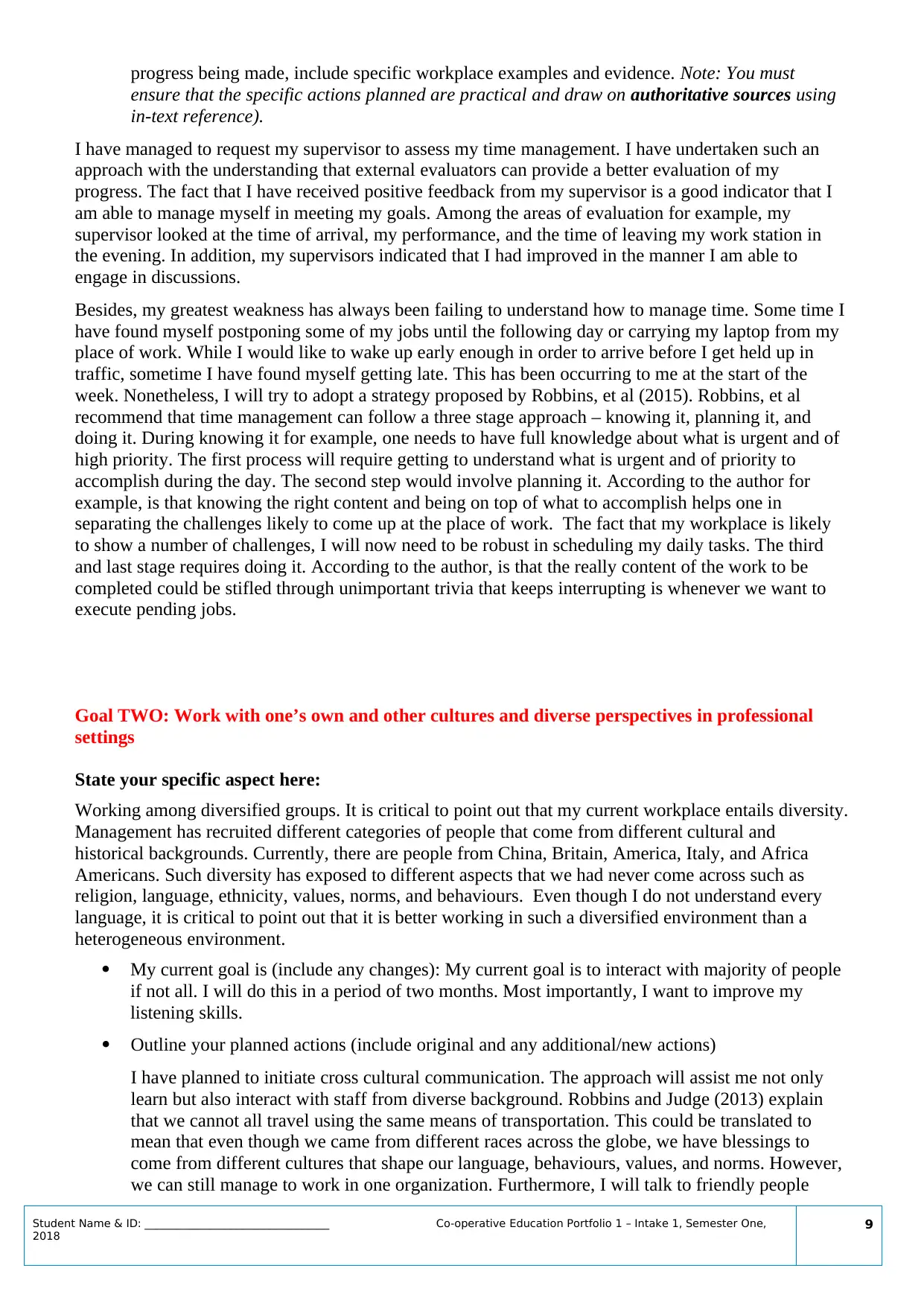
progress being made, include specific workplace examples and evidence. Note: You must
ensure that the specific actions planned are practical and draw on authoritative sources using
in-text reference).
I have managed to request my supervisor to assess my time management. I have undertaken such an
approach with the understanding that external evaluators can provide a better evaluation of my
progress. The fact that I have received positive feedback from my supervisor is a good indicator that I
am able to manage myself in meeting my goals. Among the areas of evaluation for example, my
supervisor looked at the time of arrival, my performance, and the time of leaving my work station in
the evening. In addition, my supervisors indicated that I had improved in the manner I am able to
engage in discussions.
Besides, my greatest weakness has always been failing to understand how to manage time. Some time I
have found myself postponing some of my jobs until the following day or carrying my laptop from my
place of work. While I would like to wake up early enough in order to arrive before I get held up in
traffic, sometime I have found myself getting late. This has been occurring to me at the start of the
week. Nonetheless, I will try to adopt a strategy proposed by Robbins, et al (2015). Robbins, et al
recommend that time management can follow a three stage approach – knowing it, planning it, and
doing it. During knowing it for example, one needs to have full knowledge about what is urgent and of
high priority. The first process will require getting to understand what is urgent and of priority to
accomplish during the day. The second step would involve planning it. According to the author for
example, is that knowing the right content and being on top of what to accomplish helps one in
separating the challenges likely to come up at the place of work. The fact that my workplace is likely
to show a number of challenges, I will now need to be robust in scheduling my daily tasks. The third
and last stage requires doing it. According to the author, is that the really content of the work to be
completed could be stifled through unimportant trivia that keeps interrupting is whenever we want to
execute pending jobs.
Goal TWO: Work with one’s own and other cultures and diverse perspectives in professional
settings
State your specific aspect here:
Working among diversified groups. It is critical to point out that my current workplace entails diversity.
Management has recruited different categories of people that come from different cultural and
historical backgrounds. Currently, there are people from China, Britain, America, Italy, and Africa
Americans. Such diversity has exposed to different aspects that we had never come across such as
religion, language, ethnicity, values, norms, and behaviours. Even though I do not understand every
language, it is critical to point out that it is better working in such a diversified environment than a
heterogeneous environment.
My current goal is (include any changes): My current goal is to interact with majority of people
if not all. I will do this in a period of two months. Most importantly, I want to improve my
listening skills.
Outline your planned actions (include original and any additional/new actions)
I have planned to initiate cross cultural communication. The approach will assist me not only
learn but also interact with staff from diverse background. Robbins and Judge (2013) explain
that we cannot all travel using the same means of transportation. This could be translated to
mean that even though we came from different races across the globe, we have blessings to
come from different cultures that shape our language, behaviours, values, and norms. However,
we can still manage to work in one organization. Furthermore, I will talk to friendly people
Student Name & ID: __________________________________ Co-operative Education Portfolio 1 – Intake 1, Semester One,
2018
9
ensure that the specific actions planned are practical and draw on authoritative sources using
in-text reference).
I have managed to request my supervisor to assess my time management. I have undertaken such an
approach with the understanding that external evaluators can provide a better evaluation of my
progress. The fact that I have received positive feedback from my supervisor is a good indicator that I
am able to manage myself in meeting my goals. Among the areas of evaluation for example, my
supervisor looked at the time of arrival, my performance, and the time of leaving my work station in
the evening. In addition, my supervisors indicated that I had improved in the manner I am able to
engage in discussions.
Besides, my greatest weakness has always been failing to understand how to manage time. Some time I
have found myself postponing some of my jobs until the following day or carrying my laptop from my
place of work. While I would like to wake up early enough in order to arrive before I get held up in
traffic, sometime I have found myself getting late. This has been occurring to me at the start of the
week. Nonetheless, I will try to adopt a strategy proposed by Robbins, et al (2015). Robbins, et al
recommend that time management can follow a three stage approach – knowing it, planning it, and
doing it. During knowing it for example, one needs to have full knowledge about what is urgent and of
high priority. The first process will require getting to understand what is urgent and of priority to
accomplish during the day. The second step would involve planning it. According to the author for
example, is that knowing the right content and being on top of what to accomplish helps one in
separating the challenges likely to come up at the place of work. The fact that my workplace is likely
to show a number of challenges, I will now need to be robust in scheduling my daily tasks. The third
and last stage requires doing it. According to the author, is that the really content of the work to be
completed could be stifled through unimportant trivia that keeps interrupting is whenever we want to
execute pending jobs.
Goal TWO: Work with one’s own and other cultures and diverse perspectives in professional
settings
State your specific aspect here:
Working among diversified groups. It is critical to point out that my current workplace entails diversity.
Management has recruited different categories of people that come from different cultural and
historical backgrounds. Currently, there are people from China, Britain, America, Italy, and Africa
Americans. Such diversity has exposed to different aspects that we had never come across such as
religion, language, ethnicity, values, norms, and behaviours. Even though I do not understand every
language, it is critical to point out that it is better working in such a diversified environment than a
heterogeneous environment.
My current goal is (include any changes): My current goal is to interact with majority of people
if not all. I will do this in a period of two months. Most importantly, I want to improve my
listening skills.
Outline your planned actions (include original and any additional/new actions)
I have planned to initiate cross cultural communication. The approach will assist me not only
learn but also interact with staff from diverse background. Robbins and Judge (2013) explain
that we cannot all travel using the same means of transportation. This could be translated to
mean that even though we came from different races across the globe, we have blessings to
come from different cultures that shape our language, behaviours, values, and norms. However,
we can still manage to work in one organization. Furthermore, I will talk to friendly people
Student Name & ID: __________________________________ Co-operative Education Portfolio 1 – Intake 1, Semester One,
2018
9
⊘ This is a preview!⊘
Do you want full access?
Subscribe today to unlock all pages.

Trusted by 1+ million students worldwide
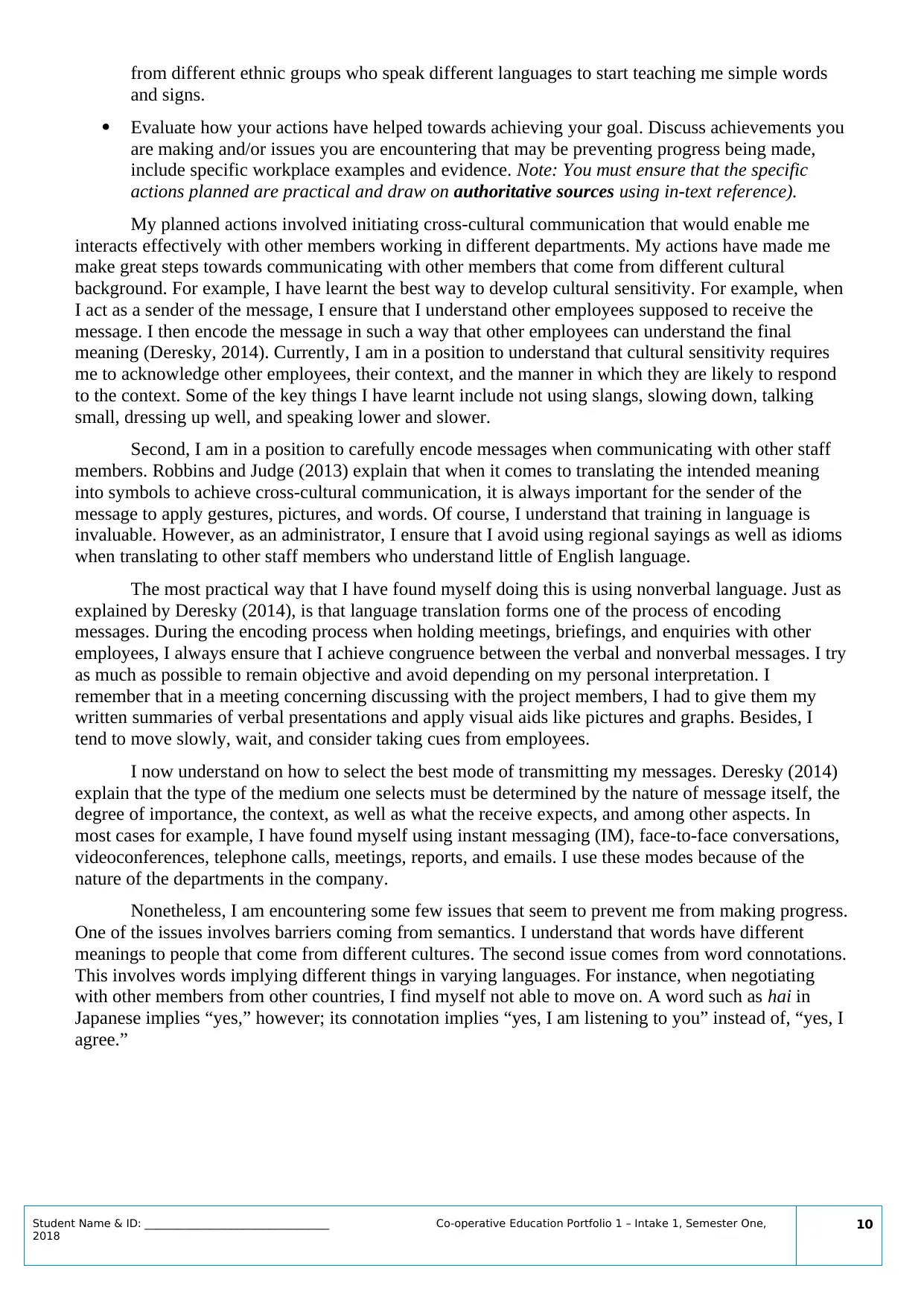
from different ethnic groups who speak different languages to start teaching me simple words
and signs.
Evaluate how your actions have helped towards achieving your goal. Discuss achievements you
are making and/or issues you are encountering that may be preventing progress being made,
include specific workplace examples and evidence. Note: You must ensure that the specific
actions planned are practical and draw on authoritative sources using in-text reference).
My planned actions involved initiating cross-cultural communication that would enable me
interacts effectively with other members working in different departments. My actions have made me
make great steps towards communicating with other members that come from different cultural
background. For example, I have learnt the best way to develop cultural sensitivity. For example, when
I act as a sender of the message, I ensure that I understand other employees supposed to receive the
message. I then encode the message in such a way that other employees can understand the final
meaning (Deresky, 2014). Currently, I am in a position to understand that cultural sensitivity requires
me to acknowledge other employees, their context, and the manner in which they are likely to respond
to the context. Some of the key things I have learnt include not using slangs, slowing down, talking
small, dressing up well, and speaking lower and slower.
Second, I am in a position to carefully encode messages when communicating with other staff
members. Robbins and Judge (2013) explain that when it comes to translating the intended meaning
into symbols to achieve cross-cultural communication, it is always important for the sender of the
message to apply gestures, pictures, and words. Of course, I understand that training in language is
invaluable. However, as an administrator, I ensure that I avoid using regional sayings as well as idioms
when translating to other staff members who understand little of English language.
The most practical way that I have found myself doing this is using nonverbal language. Just as
explained by Deresky (2014), is that language translation forms one of the process of encoding
messages. During the encoding process when holding meetings, briefings, and enquiries with other
employees, I always ensure that I achieve congruence between the verbal and nonverbal messages. I try
as much as possible to remain objective and avoid depending on my personal interpretation. I
remember that in a meeting concerning discussing with the project members, I had to give them my
written summaries of verbal presentations and apply visual aids like pictures and graphs. Besides, I
tend to move slowly, wait, and consider taking cues from employees.
I now understand on how to select the best mode of transmitting my messages. Deresky (2014)
explain that the type of the medium one selects must be determined by the nature of message itself, the
degree of importance, the context, as well as what the receive expects, and among other aspects. In
most cases for example, I have found myself using instant messaging (IM), face-to-face conversations,
videoconferences, telephone calls, meetings, reports, and emails. I use these modes because of the
nature of the departments in the company.
Nonetheless, I am encountering some few issues that seem to prevent me from making progress.
One of the issues involves barriers coming from semantics. I understand that words have different
meanings to people that come from different cultures. The second issue comes from word connotations.
This involves words implying different things in varying languages. For instance, when negotiating
with other members from other countries, I find myself not able to move on. A word such as hai in
Japanese implies “yes,” however; its connotation implies “yes, I am listening to you” instead of, “yes, I
agree.”
Student Name & ID: __________________________________ Co-operative Education Portfolio 1 – Intake 1, Semester One,
2018
10
and signs.
Evaluate how your actions have helped towards achieving your goal. Discuss achievements you
are making and/or issues you are encountering that may be preventing progress being made,
include specific workplace examples and evidence. Note: You must ensure that the specific
actions planned are practical and draw on authoritative sources using in-text reference).
My planned actions involved initiating cross-cultural communication that would enable me
interacts effectively with other members working in different departments. My actions have made me
make great steps towards communicating with other members that come from different cultural
background. For example, I have learnt the best way to develop cultural sensitivity. For example, when
I act as a sender of the message, I ensure that I understand other employees supposed to receive the
message. I then encode the message in such a way that other employees can understand the final
meaning (Deresky, 2014). Currently, I am in a position to understand that cultural sensitivity requires
me to acknowledge other employees, their context, and the manner in which they are likely to respond
to the context. Some of the key things I have learnt include not using slangs, slowing down, talking
small, dressing up well, and speaking lower and slower.
Second, I am in a position to carefully encode messages when communicating with other staff
members. Robbins and Judge (2013) explain that when it comes to translating the intended meaning
into symbols to achieve cross-cultural communication, it is always important for the sender of the
message to apply gestures, pictures, and words. Of course, I understand that training in language is
invaluable. However, as an administrator, I ensure that I avoid using regional sayings as well as idioms
when translating to other staff members who understand little of English language.
The most practical way that I have found myself doing this is using nonverbal language. Just as
explained by Deresky (2014), is that language translation forms one of the process of encoding
messages. During the encoding process when holding meetings, briefings, and enquiries with other
employees, I always ensure that I achieve congruence between the verbal and nonverbal messages. I try
as much as possible to remain objective and avoid depending on my personal interpretation. I
remember that in a meeting concerning discussing with the project members, I had to give them my
written summaries of verbal presentations and apply visual aids like pictures and graphs. Besides, I
tend to move slowly, wait, and consider taking cues from employees.
I now understand on how to select the best mode of transmitting my messages. Deresky (2014)
explain that the type of the medium one selects must be determined by the nature of message itself, the
degree of importance, the context, as well as what the receive expects, and among other aspects. In
most cases for example, I have found myself using instant messaging (IM), face-to-face conversations,
videoconferences, telephone calls, meetings, reports, and emails. I use these modes because of the
nature of the departments in the company.
Nonetheless, I am encountering some few issues that seem to prevent me from making progress.
One of the issues involves barriers coming from semantics. I understand that words have different
meanings to people that come from different cultures. The second issue comes from word connotations.
This involves words implying different things in varying languages. For instance, when negotiating
with other members from other countries, I find myself not able to move on. A word such as hai in
Japanese implies “yes,” however; its connotation implies “yes, I am listening to you” instead of, “yes, I
agree.”
Student Name & ID: __________________________________ Co-operative Education Portfolio 1 – Intake 1, Semester One,
2018
10
Paraphrase This Document
Need a fresh take? Get an instant paraphrase of this document with our AI Paraphraser
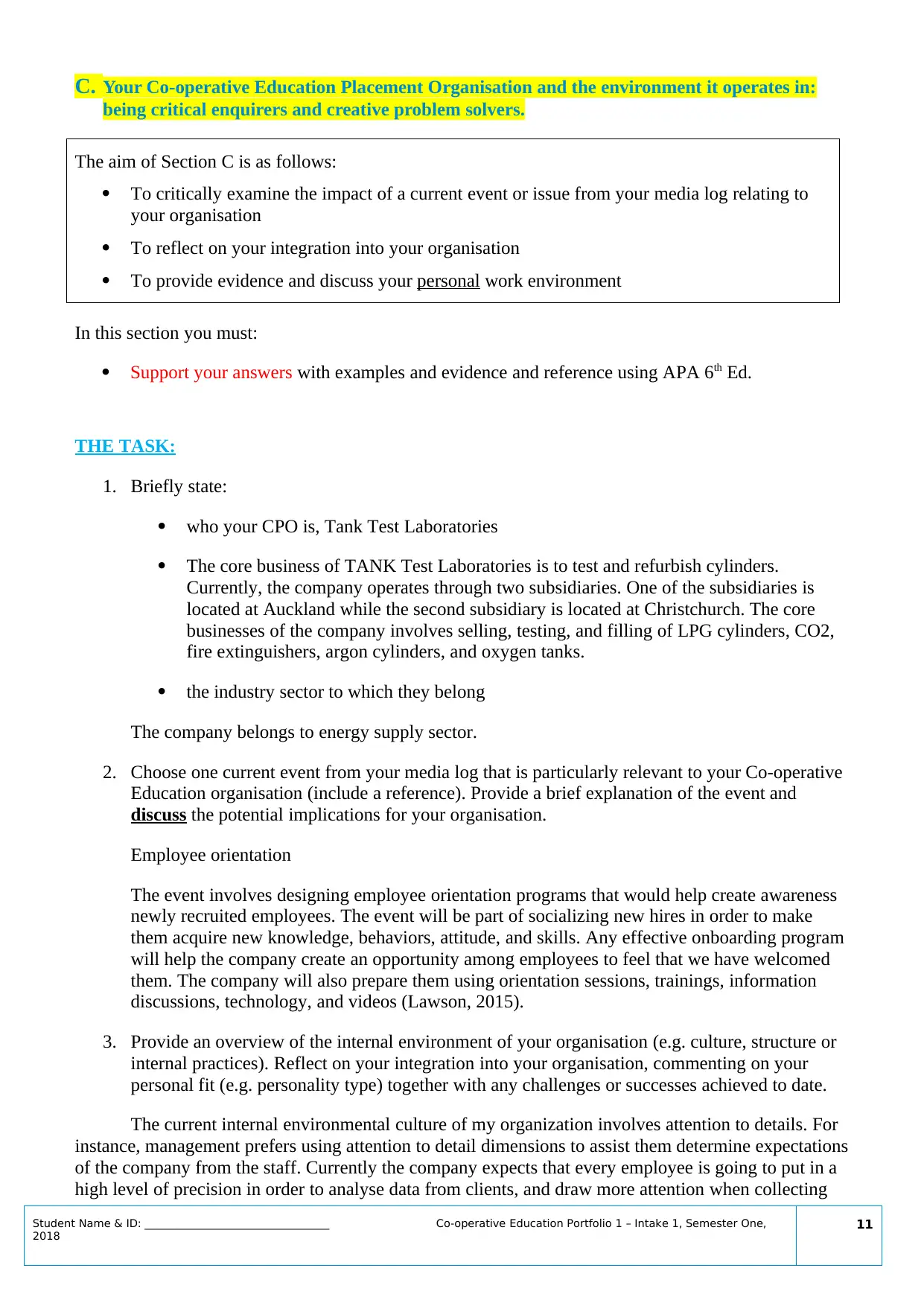
C. Your Co-operative Education Placement Organisation and the environment it operates in:
being critical enquirers and creative problem solvers.
The aim of Section C is as follows:
To critically examine the impact of a current event or issue from your media log relating to
your organisation
To reflect on your integration into your organisation
To provide evidence and discuss your personal work environment
In this section you must:
Support your answers with examples and evidence and reference using APA 6th Ed.
THE TASK:
1. Briefly state:
who your CPO is, Tank Test Laboratories
The core business of TANK Test Laboratories is to test and refurbish cylinders.
Currently, the company operates through two subsidiaries. One of the subsidiaries is
located at Auckland while the second subsidiary is located at Christchurch. The core
businesses of the company involves selling, testing, and filling of LPG cylinders, CO2,
fire extinguishers, argon cylinders, and oxygen tanks.
the industry sector to which they belong
The company belongs to energy supply sector.
2. Choose one current event from your media log that is particularly relevant to your Co-operative
Education organisation (include a reference). Provide a brief explanation of the event and
discuss the potential implications for your organisation.
Employee orientation
The event involves designing employee orientation programs that would help create awareness
newly recruited employees. The event will be part of socializing new hires in order to make
them acquire new knowledge, behaviors, attitude, and skills. Any effective onboarding program
will help the company create an opportunity among employees to feel that we have welcomed
them. The company will also prepare them using orientation sessions, trainings, information
discussions, technology, and videos (Lawson, 2015).
3. Provide an overview of the internal environment of your organisation (e.g. culture, structure or
internal practices). Reflect on your integration into your organisation, commenting on your
personal fit (e.g. personality type) together with any challenges or successes achieved to date.
The current internal environmental culture of my organization involves attention to details. For
instance, management prefers using attention to detail dimensions to assist them determine expectations
of the company from the staff. Currently the company expects that every employee is going to put in a
high level of precision in order to analyse data from clients, and draw more attention when collecting
Student Name & ID: __________________________________ Co-operative Education Portfolio 1 – Intake 1, Semester One,
2018
11
being critical enquirers and creative problem solvers.
The aim of Section C is as follows:
To critically examine the impact of a current event or issue from your media log relating to
your organisation
To reflect on your integration into your organisation
To provide evidence and discuss your personal work environment
In this section you must:
Support your answers with examples and evidence and reference using APA 6th Ed.
THE TASK:
1. Briefly state:
who your CPO is, Tank Test Laboratories
The core business of TANK Test Laboratories is to test and refurbish cylinders.
Currently, the company operates through two subsidiaries. One of the subsidiaries is
located at Auckland while the second subsidiary is located at Christchurch. The core
businesses of the company involves selling, testing, and filling of LPG cylinders, CO2,
fire extinguishers, argon cylinders, and oxygen tanks.
the industry sector to which they belong
The company belongs to energy supply sector.
2. Choose one current event from your media log that is particularly relevant to your Co-operative
Education organisation (include a reference). Provide a brief explanation of the event and
discuss the potential implications for your organisation.
Employee orientation
The event involves designing employee orientation programs that would help create awareness
newly recruited employees. The event will be part of socializing new hires in order to make
them acquire new knowledge, behaviors, attitude, and skills. Any effective onboarding program
will help the company create an opportunity among employees to feel that we have welcomed
them. The company will also prepare them using orientation sessions, trainings, information
discussions, technology, and videos (Lawson, 2015).
3. Provide an overview of the internal environment of your organisation (e.g. culture, structure or
internal practices). Reflect on your integration into your organisation, commenting on your
personal fit (e.g. personality type) together with any challenges or successes achieved to date.
The current internal environmental culture of my organization involves attention to details. For
instance, management prefers using attention to detail dimensions to assist them determine expectations
of the company from the staff. Currently the company expects that every employee is going to put in a
high level of precision in order to analyse data from clients, and draw more attention when collecting
Student Name & ID: __________________________________ Co-operative Education Portfolio 1 – Intake 1, Semester One,
2018
11
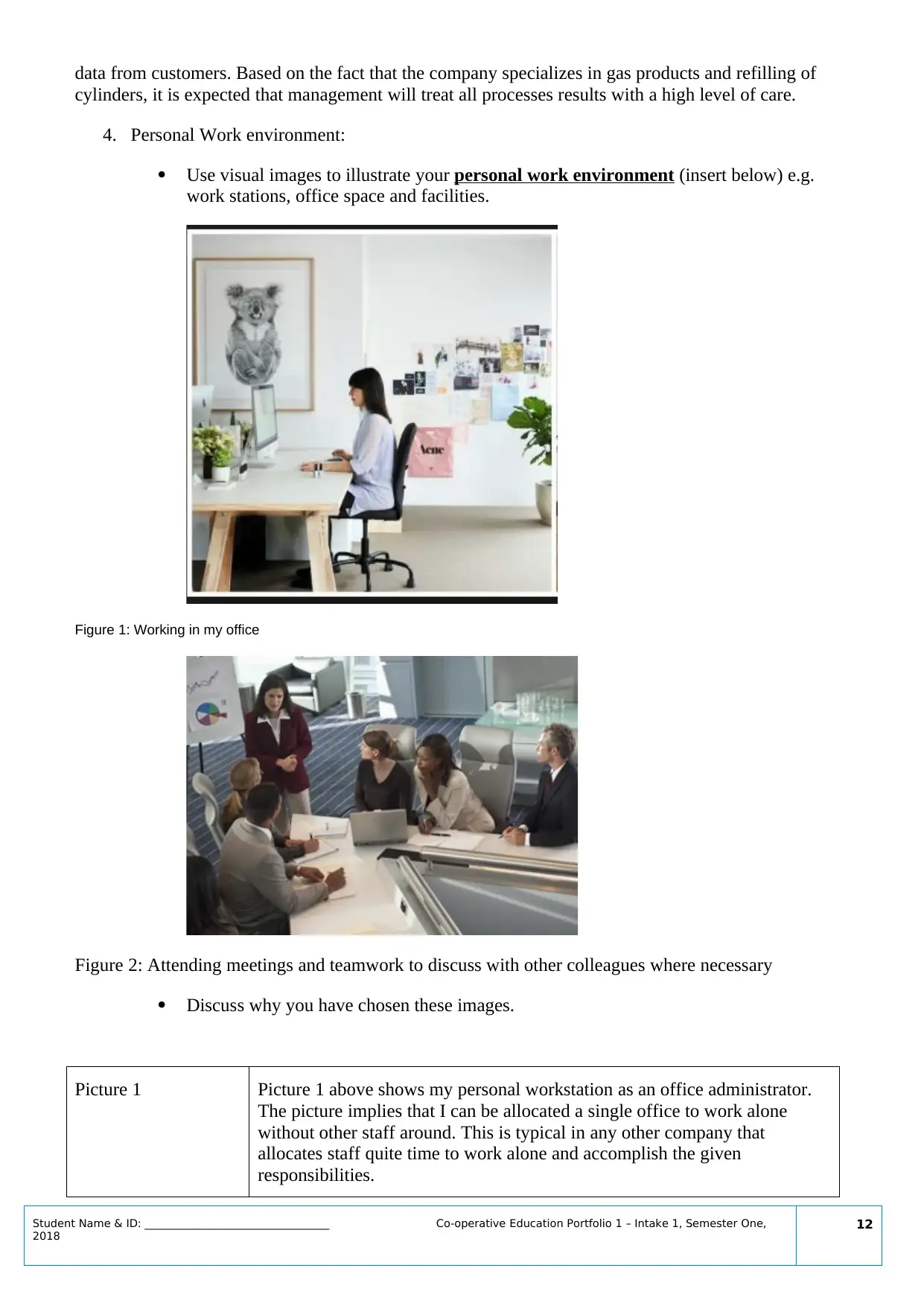
data from customers. Based on the fact that the company specializes in gas products and refilling of
cylinders, it is expected that management will treat all processes results with a high level of care.
4. Personal Work environment:
Use visual images to illustrate your personal work environment (insert below) e.g.
work stations, office space and facilities.
Figure 1: Working in my office
Figure 2: Attending meetings and teamwork to discuss with other colleagues where necessary
Discuss why you have chosen these images.
Picture 1 Picture 1 above shows my personal workstation as an office administrator.
The picture implies that I can be allocated a single office to work alone
without other staff around. This is typical in any other company that
allocates staff quite time to work alone and accomplish the given
responsibilities.
Student Name & ID: __________________________________ Co-operative Education Portfolio 1 – Intake 1, Semester One,
2018
12
cylinders, it is expected that management will treat all processes results with a high level of care.
4. Personal Work environment:
Use visual images to illustrate your personal work environment (insert below) e.g.
work stations, office space and facilities.
Figure 1: Working in my office
Figure 2: Attending meetings and teamwork to discuss with other colleagues where necessary
Discuss why you have chosen these images.
Picture 1 Picture 1 above shows my personal workstation as an office administrator.
The picture implies that I can be allocated a single office to work alone
without other staff around. This is typical in any other company that
allocates staff quite time to work alone and accomplish the given
responsibilities.
Student Name & ID: __________________________________ Co-operative Education Portfolio 1 – Intake 1, Semester One,
2018
12
⊘ This is a preview!⊘
Do you want full access?
Subscribe today to unlock all pages.

Trusted by 1+ million students worldwide
1 out of 22
Related Documents
Your All-in-One AI-Powered Toolkit for Academic Success.
+13062052269
info@desklib.com
Available 24*7 on WhatsApp / Email
![[object Object]](/_next/static/media/star-bottom.7253800d.svg)
Unlock your academic potential
Copyright © 2020–2025 A2Z Services. All Rights Reserved. Developed and managed by ZUCOL.





